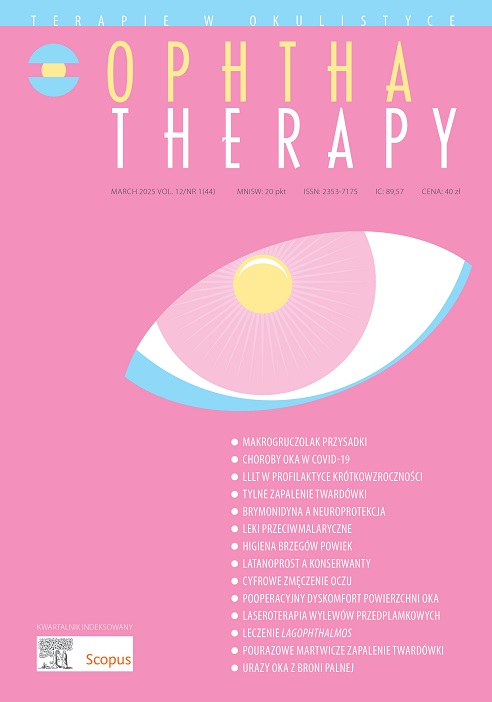Neuroprotection in glaucoma – what is the role of brimonidine? Review article
Main Article Content
Abstract
Glaucoma is a chronic, multifactorial, progressive optic neuropathy and if left untreated, leads to total blindness. Damage to retinal ganglion cells and their axons in glaucoma may be caused by increased intraocular pressure, ischemia, oxidative stress, glutamate neurotoxicity, or deficiency of neurotrophic growth factor. Brimonidine is an α2-adrenergic receptor agonist, a drug commonly used to lower intraocular pressure. Its action is to inhibit the production of aqueous humor and increase its outflow by an unconventional (uveoscleral) route. The neuroprotective mechanism of action of brimonidine is believed to be related to the reduction of extracellular glutamate and blocking the activation of N-methyl-D-aspartate (NMDA) receptors, as well as the activation of brain-derived neurotrophic factor (BDNF protein) and fibroblast growth factor and their receptors, vascular modulation improving microcirculation, and regulation of cell survival and apoptosis signals. Studies have shown that 0.2% brimonidine protects retinal ganglion cells from death, not only in the mechanism of lowering IOP. The use of neuroprotective treatment of retinal ganglion cells is a promising route in glaucoma therapy.
Downloads
Article Details
Copyright: © Medical Education sp. z o.o. License allowing third parties to copy and redistribute the material in any medium or format and to remix, transform, and build upon the material, provided the original work is properly cited and states its license.
Address reprint requests to: Medical Education, Marcin Kuźma (marcin.kuzma@mededu.pl)
References
2. Kass MA, Heuer DK, Higginbotham EJ et al. The Ocular Hypertension Treatment Study: A randomized trial determines that topical ocular hypotensive medication delays or prevents the onset of primary open-angle glaucoma. Arch Ophthalmol. 2002; 120: 701-13. http://doi.org/10.1001/archopht.120.6.701.
3. Comparison of glaucomatous progression between untreated patients with normal-tension glaucoma and patients with therapeutically reduced intraocular pressures. Collaborative Normal-Tension Glaucoma Study Group. Am J Ophthalmol. 1998; 126: 487-97. http://doi.org/10.1016/s0002-9394(98)00223-2.
4. Vishwaraj CR, Kavitha S, Venkatesh R et al. Neuroprotection in glaucoma. Indian J Ophthalmol. 2022; 70(2): 380-5. http://doi.org/10.4103/ijo.IJO_1158_21.
5. Doozandeh A, Yazdani S. Neuroprotection in Glaucoma. J Ophthalmic Vis Res. 2016; 11(2): 209-20. http://doi.org/10.4103/2008-322X.183923.
6. Weinreb RN, Levin LA. Is neuroprotection a viable therapy for glaucoma? Arch Ophthalmol. 1999; 117(11): 1540-4. http://doi.org/10.1001/archopht.117.11.1540.
7. Asanad S, Chang J, Aref AA. et al. Neuroprotection in Glaucoma .
8. Basic and Clinical Science Course, Section 10: Glaucoma. 2024-2025 edition.
9. Donello J, Padillo E, Webster M et al. α2-Adrenoceptor Agonists Inhibit Vitreal Glutamate and Aspartate Accumulation and Preserve Retinal Function after Transient Ischemia. J Pharmacol Exp Ther. 2001; 296(1): 216-23.
10. Wheeler L, Woldemussie E, Lai R. Role of Alpha-2 Agonists in Neuroprotection. Survey Ophthal. 2003; 48: S47-51.
11. Lai R, Chun T, Hasson D et al. Alpha-2 adrenoceptor agonist protects retinal function after acute retinal ischemic injury in the rat. Vis Neurosci. 2002; 19: 175-85.
12. Hernández M, Urcola JH, Vecino E. Retinal ganglion cell neuroprotection in a rat model of glaucoma following brimonidine, latanoprost or combined treatments. Exp Eye Res. 2008; 86(5): 798-806.
13. Woldemussie E, Ruiz G, Wijono M et al. Neuroprotection of retinal ganglion cells by brimonidine in rats with laser-induced chronic ocular hypertension. Invest Ophthalmol Vis Sci. 2001; 42: 2849-55.
14. Mohamed J, Abo-Elkhei O. The Role of Brimonidine Eye Drops as an Adjunctive Therapy for Optic Nerve Protection in Patients with Controlled Open Angle Glaucoma. Egypt J Hosp Med. 2017; 68(3): 1418-24.
15. Krupin T, Liebmann J, Greenfield D et al. A randomized trial of brimonidine versus timolol in preserving visual function: results from the Low-Pressure Glaucoma Treatment Study. Am J Ophthalmol. 2011; 151(4): 671-81.
16. Tsai J-C, Chang H-W. Comparison of the effects of brimonidine 0.2% and timolol 0.5% on retinal nerve fiber layer thickness in ocular hypertensive patients: a prospective, unmasked study. J Ocul Pharmacol Ther. 2005; 21: 475-82.
17. Kent A, Nussdorf J, David R et al. Vitreous concentration of topically applied brimonidine tartrate 0.2%. Ophthalmology. 2001; 108(4): 784-7.

